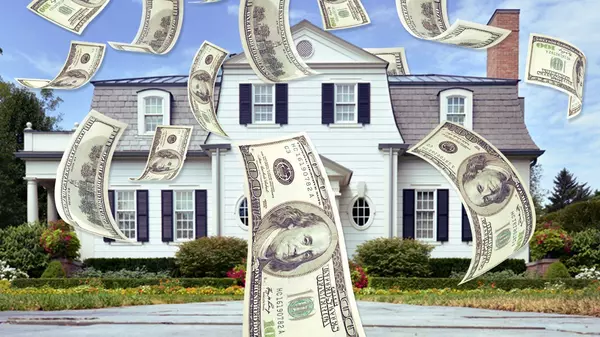1 in 3 Americans Face Housing Risks With No Savings and Rising Insurance Trouble
Life can be full of surprises, so having emergency savings is essential to anyone's personal finance well-being—especially for homeowners, who are facing skyrocketing costs and vanishing insurance options.
And yet, 1 in 3 Americans has no emergency savings set aside, according to a recent Empower survey.
For those living in climate-risk areas, it's more important than ever to be prepared for when disaster strikes, and experts agree that starts with having money set aside for unexpected circumstances.
Savings are shrinking for too many Americans
In addition to finding that 32% of Americans don’t have an emergency fund, the Empower survey found that an eye-popping 29% say they cannot afford an unexpected expense over $400.
Historically, experts have recommended that emergency savings represent three to six months of living expenses, which include rent and/or mortgage payments, utilities, and food.
And yet, the survey found that Americans’ average emergency savings is $500—a far cry from the recommended amount and certainly not a significant enough sum that could cover home repairs, if necessary.
In climate-risk states, savings matter even more, as insurance premiums often rise “in areas with the highest risk of natural disasters such as hurricanes or wildfires,” according to the National Bureau of Economic Research.
In fact, more than half (58%) of homeowners say they’d consider going without insurance if the price got too high, according to a Realtor.com® survey. And the timing couldn’t be worse.
More than $12.7 trillion worth of U.S. real estate now faces severe or extreme climate risk, according to the most recent Realtor.com Housing and Climate Risk Report. As insurers raise rates or pull out of high-risk areas altogether, homeowners are left with fewer choices, higher costs, and—sometimes—no coverage at all. Already, as many as 1 in 7 homes does not have insurance.
Max Dugan-Knight, climate data scientist at Deep Sky, adds that many homeowners in high climate-risk areas, like wildfire-prone parts of California or hurricane-vulnerable sections of the U.S. Southeast, are actually being forced to go without home insurance.
“Insurance companies are recognizing that risk of property damage is growing quickly, and they are either raising rates or abandoning these areas entirely,” he says, adding that the Deep Sky Research 2025 Wildfire Report found that 1 in 5 homes in extreme fire-risk areas of California have lost coverage since 2019.
“Home insurance premiums shot up 42% in the most fire-prone areas of California. Even the cost of policies from state insurers of last resort like California's FAIR plan has increased,” he says.
Given this, Dugan-Knight says an emergency fund can serve as a safety net if homeowners lose coverage, or as a supplemental resource when insurance doesn’t cover everything.
How much emergency savings should homeowners really have?
With this in mind, Melanie Musson, an insurance and finance expert at Clearsurance.com, recommends setting aside a fund for your home insurance deductible so that if your home is damaged, you can afford the deductible, and the insurance will take care of the rest.
“If you can’t find insurance or you have to get a state-sponsored home insurance policy, you will be extremely underinsured, and your savings will need to reflect your higher risk,” she says.
Bhavin Swadas, a real estate and finance expert at Roar The Deal, agrees, saying that a larger fund is necessary in climate-risk states where insurance is lacking or expensive.
Swadas suggests that a six- to 12-month target will offer the financial flexibility to cover major repairs, insurance deductibles, or long-term displacement due to natural disasters.
“This additional buffer prevents the dependence on the high-interest credit or liquidation of assets,” he adds.
If you have reliable insurance, it’s still smart to keep a fund that covers three to six months of your mortgage and living expenses, he says. That way, you’re prepared for the everyday emergencies—like a broken appliance, a leaky roof, or even a short-term loss of income.
Where homeowners should keep emergency savings
In emergencies, accessibility and liquidity are essential.
“One of the lessons I have learned over the years, after working with hundreds of clients, is the importance of having access to money. Even if you don’t get the best rate of return," explains Lance Morgan, founder and CEO of Legetty Educational Services and creator of College Funding Secrets. "Sometimes, access to the money is more valuable and could prevent racking up credit cards or losing your house."
With this in mind, homeowners have several options to stash their savings.
Steve Sexton, CEO of Sexton Advisory Group, recommends HYSAs or money market accounts as ideal vehicles for storing your emergency fund because they offer a modest return while keeping your money readily available.
“CDs, which lock money up for a specific period of time, are less accessible; and with emergency funds, the goal isn't to maximize returns but to have quick, penalty-free access to your cash when life throws you a curveball,” he says.
“Tying up your emergency fund in long-term assets (stocks, retirement accounts, or CDs with long maturities) means that you won't be able to get to it quickly in the event of an emergency,” he adds.
This is why he said having separate savings buckets for emergencies and long-term goals is critical.
Additionally, Jay Zigmont, Ph.D., CFP, founder of financial planning firm Childfree Trust, says his house was hit by lightning a couple of years ago, and he benefited from having cold, hard cash on hand.
“Cash is key, as you can often get people to help faster with cash than with a credit card,” he notes.
For homeowners, he always suggests first having $1,000 in cash set aside for emergencies.
Categories
Recent Posts










GET MORE INFORMATION

